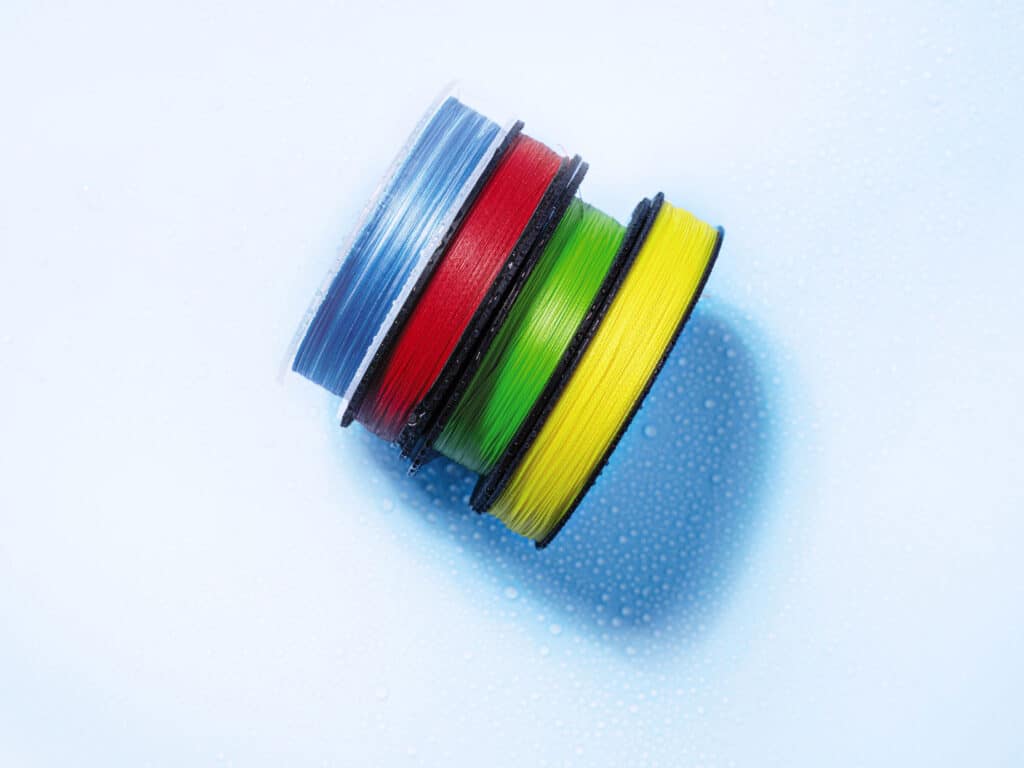
| Sufix 832 Advanced | PowerPro | Seaguar Smackdown | SpiderWire DuraBraid |
| This superline relies on an eight-strand braid to be exceptionally smooth, with excellent handling characteristics, long casting abilities and a thin diameter. | Made using low-stretch Spectra fibers with enhanced body technology for easy handling, this braided line is an angler favorite for a variety of techniques. | The smooth, round body of this line gives it exceptional casting abilities, allowing anglers to place lures and bait with laserlike precision and stealth. | SpiderWire was already known for its amazing abrasion resistance, but DuraBraid improves on that performance by being 25 percent more durable. |
We know fish can see color and are often attracted to brightly colored lures from far away. So, could bright lines impact our hookup ratios? We reached out to David A. Ross, Ph.D., oceanographer and Scientist Emeritus at the Woods Hole Oceanographic Institution, avid inshore angler, and author of the book The Fisherman’s Ocean: How Marine Science Can Help You Find and Catch More Fish, to help us answer this question.
“When it comes to line color, it’s probably a low-order factor to consider,” Ross says. Though there have been a few studies showing that vividly colored lines can negatively impact catch rates, Ross explains these were conducted in fresh water, which is quite a bit different than marine environments. He states that most fish are nearsighted, which only allows them to see detail up-close.
Fish also generally only use color vision to increase contrast to identify prey items from the background. “There are a lot of other things that are much more important: what your line is doing to the lure, if you can feel the lure through the line, or how strong it is.
“The majority of fish are much more sensitive to vibration than visual cues,” Ross says, explaining that fish make up for their poor eyesight by sensing vibration from great distances. “Fish are attracted first to the vibration and then the visual profile of your lure or bait, and become focused in on it, ignoring a lot of other smaller stimuli—like the sight or vibration of your line. By the time they get close enough to see line color, they’re likely already ignoring it. Of course, species and situations can vary.”
Further, he points out that predators are typically coming at your lure from behind or below, or ambush attacking. This means the line—regardless of color—will be well-hidden by the movement and vibration of the lure or bait, especially if you’re using one of today’s thin braided lines.
However, he did suggest that the thicker your line, potentially the more color could matter. “If I was an angler using heavy wire or very thick monofilament, I could see being worried about color.”
So it seems that, generally speaking, brightly colored line probably doesn’t hurt. But there are exceptions to every rule. “The shallower and clearer the water—and in most cases, the brighter the light—the more likely the fish is going to see your line from a distance. And some fish can see a lot better than others.”
For example, both limited scientific data and a lot of angler experience suggest that when fishing the flats, it’s probably best to avoid fluorescent colors. While factors like hull slap and poorly placed casts are far more impactful, unnaturally colored lines could hurt in these tight quarters. But it’s not just the flats; the closer to the surface you are, the more visible all colors will be, even offshore.
Again, while likely not a make-or-break factor, near-surface feeds with picky pelagics (which are known for their sharp eyesight) could be impacted by bright lines.
“I still choose natural colors, just to be safe,” Ross says when asked what color line he would personally select. According to Ross, dark greens and blues are generally a good choice around fussy fish or those with good eyesight. These colors are common throughout the aquatic world, but picking a color that blends into your specific environment is best.
“If you want to use bright line, I think using fluorocarbon leaders makes a lot of sense and will help offset any impact.” For virtually all situations, but especially when using brightly colored line, Ross is an adamant supporter of using long, clear leaders. He says that fluorocarbon made sense because it is one of the least visible choices and would almost certainly eliminate fish seeing even fluorescent-colored main lines. Because fish are so nearsighted, having just a few feet of clear leader could mean the fish wouldn’t even notice (or physically couldn’t even see) the main line, regardless of color.
Read Next: How Often Should You Replace Your Fishing Line?
So it seems that brightly colored main lines probably aren’t a huge turnoff for most fish, but they can benefit anglers in certain cases. If you’re fishing in cloudy, stained water and the bright hue of your line helps track the whereabouts of your lure for better presentation, then it’s likely best to stick with it. After all, precision is paramount; if your lure isn’t where the fish are biting, it doesn’t matter what color line you’re using. Bright lines can also aid anglers trolling offshore in sunny, bluebird-sky conditions, allowing them to track how deep or far from the boat their offerings are. They can also help prevent tangles when using multiple rods.
As with all things fishing, there’s rarely ever a one-size-fits-all solution. You have to analyze your needs and then determine which line color is best for your particular species, environment and angling technique.









